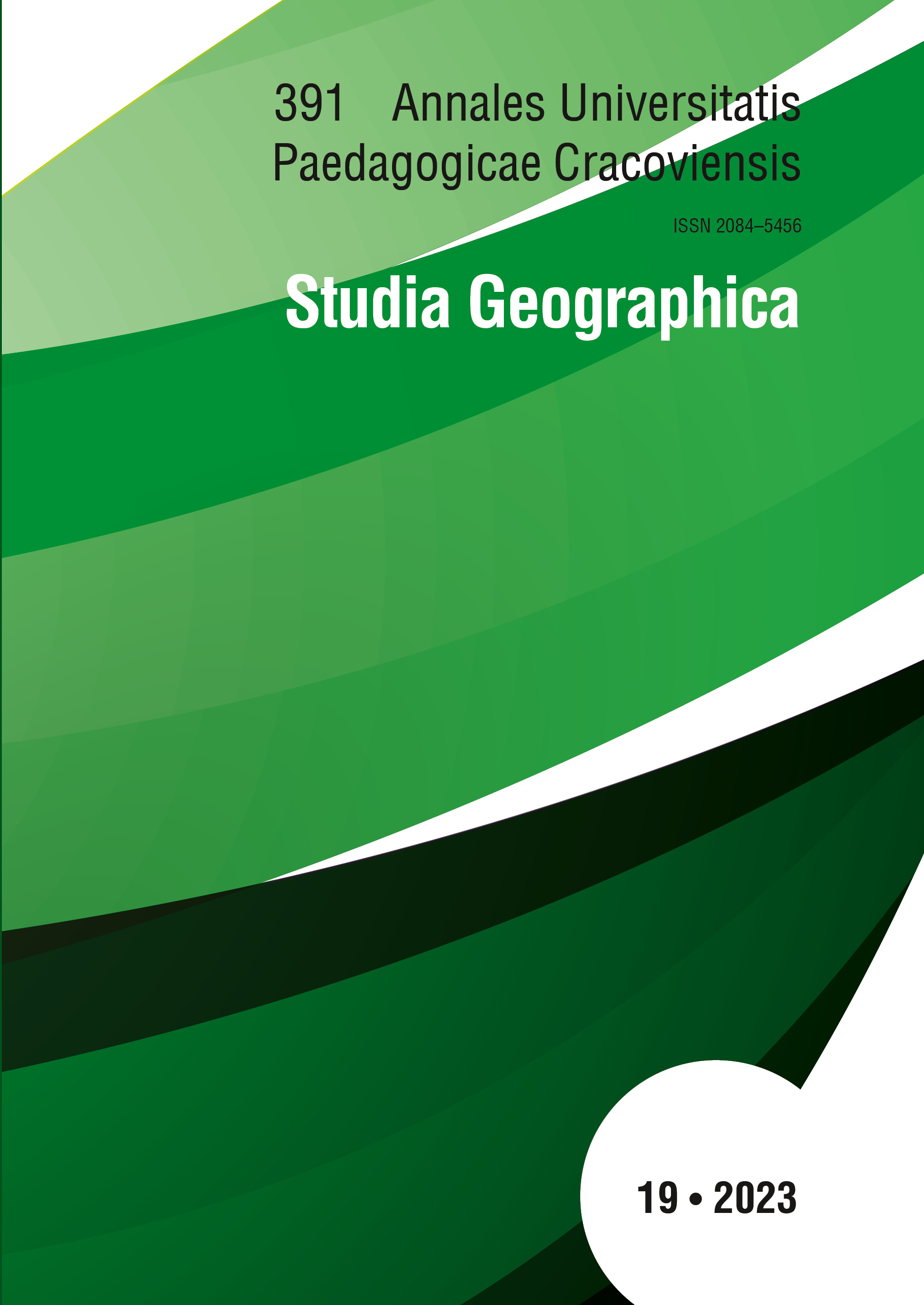The ethno‑racial diversity of Peru’s population in light of 2017 census data
DOI:
https://doi.org/10.24917/20845456.19.4Keywords:
Peru, ethno‑racial structure, Afro‑Peruvians, Andean Indians, Amazonian IndiansAbstract
The aim of this article is to examine the ethno‑racial structure of the Peruvian population in light of data from the 2017 census. This census included, for the first time, a question on the ethno‑racial self‑identification of residents aged 12 years and over. The census results made available determine the size, spatial distribution and basic demographic characteristics of the three main ethno‑racial minorities of Peru declaring themselves as: Andean Indians, Amazonian Indians and Afro‑Peruvians, against the rest of the population, which is mainly mestizo and white. The study examined the spatial concentration of the three main ethno‑racial minorities, which, according to the data, accounted for 29.4% of Peru’s total population. The research also found a strong spatial concentration of each of them. Andean Indians are concentrated mainly in the departments of the southern part of the country, while Amazonian Indians were mainly clustered in the departments of the northeastern and eastern parts of the country, and Afro‑Peruvians are mainly centred in the departments along the northern coast.
References
Ali, O.H. (2014). Afro‑Peru: A Legacy of Black Labor and Culture. ReVista: Harvard Review of Latin America, 14(1), 97–99.
Andrews, G.R. (2004). Afro‑Latin America: 1800–2000. Oxford–New York: Oxford University Press.
Cahill, D. (1994). Colour by Numbers: Racial and Ethnic Categories in the Viceroyalty of Peru 1532–1824. Journal of Latin American Studies, 26(2), 325–346.
Chasteen, J.C. (2007). Ogień i krew. Historia Ameryki Łacińskiej. Warszawa: Państwowy Instytut Wydawniczy.
Dobrzycki, W. (2012). Gospodarka i kwestia indiańska w kolonialnej Kolumbii. Ameryka Łacińska. Kwartalnik analityczno‑informacyjny, 3–4 (77–78), 14–30.
Feldman, H.C. (2012). Strategies of the Black Pacific: Music and Diasporic Identity in Peru. W: K. Dixon, J. Burdick (red.), Comparative Perspectives on Afro‑Latin America. Gainesville: University Press of Florida, 42–71.
Gootenberg, P. (1995). Población y etnicidad en el Perú republicano (siglo XIX): algunas revisiones. Documento de Trabajo, 71(14), 1–58.
Hummel, A., Ługowska, U. (2009). Ameryka Indiańska. W: M.F. Gawrycki (red.), Dzieje kultury latynoamerykańskiej. Warszawa: Wydawnictwo Naukowe PWN, 141–152.
INEI (2018). Censos Nacionales 2017, La Autoidenticación Étnica: Población Indigena y Afroperuana.
Kairski, M. (1999). Indianie Ameryki Środkowej i Południowej. Demografia, rozmieszczenie, sytuacja etno‑kulturowa, t. 1 – Analiza etnologiczna. Poznań: Wydawnictwo Naukowe Uniwersytetu im. Adama Mickiewicza.
Kania, M. (2016). Human Rights, Principles of Multiculturalism, and New Paths of Development in Latin America. Ad Americam. Focus on: Latin American Studies, 17, 5–10.
Kubiaczyk, F. (2011). Kontrola siły roboczej w gospodarce kolonialnej Ameryki hiszpańskiej: encomienda, repartimiento i niewolnictwo. Studia Europaea Gnesnensia, 4, 9–44.
Lisocka‑Jaegermann, B. (2009). Czarne Ameryki. W: M.F. Gawrycki (red.), Dzieje kultury latynoamerykańskiej. Warszawa: Wydawnictwo Naukowe PWN, 163–173.
Litwin, Ł. (2022). Zmiany roli i znaczenia ludności autochtonicznej w strukturze demograficzno‑społecznej Peru. Praca magisterska, Kraków: Instytut Geografii Uniwersytet Pedagogiczny w Krakowie.
Posern‑Zieliński, A. (2005). Między indygenizmem a indianizmem. Poznań: Wydawnictwo Naukowe UAM.
Riedel, E. (1990). Trzecia generacja praw człowieka jako strategia urzeczywistniania praw politycznych i społecznych. Ruch Prawniczy, Ekonomiczny i Socjologiczny, 3–4, 115–129.
Rostworowska, M. (2007). Historia Państwa Inków. Warszawa: Państwowy Instytut Wydawniczy.
Schreiber, H. (2013). Cultural genocide – ludobójstwo kulturowe – kulturobójstwo: niedokończony czy odrzucony projekt prawa międzynarodowego? W: H. Schreiber, G. Michałowska (red.), Kultura w stosunkach międzynarodowych, t. 1: Zwrot kulturowy. Warszawa: Wydawnictwo Uniwersytetu Warszawskiego, 252–274.
Szykulski, J. (2010). Starożytne Peru. Wrocław: Wydawnictwo Uniwersytetu Wrocławskiego.
Tardieu, J.P. (2018). El palenque de Guachipa (1713) Aspectos del cimarronaje en la periferia limeña (Perú). Revista del Instituto Riva‑Agüero, 3(2), 243–262.
Thorp, R., Paredes, M. (2010). Ethnicity and the Persistence of Inequality. The Case of Peru. Conflict, Inequality and Ethnicity.
Węcławowicz, G. (2007). Geografia społeczna miast. Warszawa: Wydawnictwo Naukowe PWN.
INEI (2023), Censos Nacionales 2017: XII de Población, VII de Vivienda y III de Comunidades Indígenas. Instituto Nacional de Estadística e Informática – INEI, Lima, https://censo2017.inei.gob.pe/resultados‑definitivos‑de‑los‑censos‑nacionales-2017/ (dostęp: 15.02.2023)
Downloads
Published
Issue
Section
License
Copyright (c) 2024 Annales Universitatis Paedagogicae Cracoviensis Studia Geographica

This work is licensed under a Creative Commons Attribution-NoDerivatives 4.0 International License.
The submission of a paper to be published is synonymous with an agreement to transfer the copyright free of charge from the author to the publisher. The author also agrees to permit the publisher to publish the paper in printed form, open access online form, digital library form and other digital platforms with which the publisher has or will have a publishing agreement. Furthermore, the author agrees to not limit the number of copies that may be printed or issued by the publisher. In the case of co-authored papers, it is assumed that the corresponding author is authorized to represent the remaining co-authors in this respect. Authors are requested to sign a copyright declaration.

